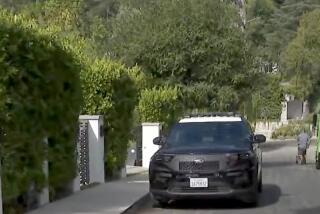New Police Commander Wants to Strengthen Attack on Drugs, Gangs
The new top cop in the San Fernando Valley describes himself as a “bouncing ball” who has had 25 different assignments in 27 years with the Los Angeles Police Department.
But Cmdr. Jim Jones, 49, said that when he takes over command of the Valley Bureau today, he expects to dig in for a stay of several years--enough time for him to leave his mark on how police serve the area of nearly 1.4 million people.
Earlier this month, Police Chief Daryl F. Gates ordered the shuffling of his top command staff in what he said was an effort to reinvigorate the leadership of his 8,400-officer force. Jones, of Newhall, who commanded police operations in West Los Angeles for two years, replaces Deputy Chief Ronald A. Frankle in the Valley.
Frankle leaves after four years to head up the Operations-Headquarters Bureau. He called Jones a top administrator with well-rounded experience. “If it had been my choice, I think I would have chosen Jim Jones as well,” Frankle said.
Jones attributes his numerous assignments to a quick climb up the department’s ladder and a willingness to seek new challenges. He has served in every bureau in the department and has held numerous management positions, including chief of staff for Gates between 1986 and 1988.
Jones said the experience will allow him to come to the Valley and “take off from the first day.” He said he has plans for new programs and ways to strengthen attacks on problems such as gangs and drugs.
Although Jones prefaced his remarks by saying he is still in the process of learning about police operations and crime problems in the Valley, he gave these answers during a recent interview:
Question: What do you see as your top immediate priority?
Answer: Regarding crime, my top priorities are the sale and abuse of narcotics, the increase in violent crimes, an apparent increase in some burglaries that may indicate a narcotics-related problem, and very near and dear to me is the spread of gang violence. A top priority is to keep gang violence from overwhelming the San Fernando Valley.
Q: Police officials have continually reported that gang problems are rising in the Valley. What can be done about it that isn’t being done now?
A: I don’t personally believe the answer to the gang problem is finding something new. What I am going to do, first of all, is make sure I am covering all the basics, that we are making arrests--not just arrests of gang members but that we are arresting criminals who happen to be gang members. Of those criminals, I want to target and prioritize those who are causing the violence. I intend to continue moving more personnel into specifically handling the gang problem. I also want to try to get rid of some gang indicators: graffiti and areas where people don’t go because gang members congregate--parks, playgrounds, street corners and parking lots. We start there, and push and push, and slowly we will make some impact.
In the long term, I am committed to working to get a coordinated effort in the approach to gang problems. We have to work on the rest of the criminal justice system, then on churches, schools and other public and private agencies so we can target what I believe will be the final cure to the gang problem. That is preventing young people from joining gangs. That takes the cooperation of the people who live in the community, the businesses and the entire criminal justice system. That is how we will eventually wear down the gang problem.
Q: The Valley’s murder rate grew 13% last year. Is murder a crime police believe they can have a preventive impact on?
A: I think the typical police response several years ago would have been that we have very little impact on preventing homicide. However, that is no longer the case. We have found by looking at it citywide--and the Valley I don’t believe is any different--that homicides traditionally used to occur inside of buildings where police don’t patrol. However, more and more, they are occurring in the streets. So I think there are some things we can do to reduce homicides. I intend to find out if homicides are occurring in the Valley in isolated pockets and then to try to put some resources into those pockets to see if it can make a difference. I believe it can.
Q: In two years commanding the West Bureau, what do you consider your top accomplishment?
A: One of the accomplishments is the experiment we have done in the Oakwood area in the Pacific Division. A 10- or 12-square-block region, Oakwood had an extremely high crime rate. We formed the Oakwood task force, a form of community-based policing that I would like to carry into the Valley. First of all, we put enough officers into the area to overwhelm the crime. The trick is to keep the crime down after we leave. In Oakwood, we cleaned up the area, we cleaned up the graffiti and we started to build a community support group--people in the area who wanted to make it a decent place to live. That task force has been in operation for a year and a half, and we have reduced the total crime in that area by 43%, a tremendous decrease.
Q: Are there areas in the Valley that could be targeted with this type of community-based policing?
A: All areas need community-based policing. I don’t care if it is Brentwood or Oakwood. It comes from an understanding that the Police Department cannot control crime without people helping us. We have to work together to have a partnership with the community, so that the community believes and understands it is their job to prevent that crime, and we are there to help them.
Q: Police in the Valley have taken the unusual step of using barricades to close crime-plagued neighborhoods to traffic in order to stop drug buyers and gang members from coming in. Do you favor this procedure? Could we see more of it in the Valley?
A: We call it cul-de-sacing--we don’t want it to look like barricades. It is one of the tools I will be considering. However, we wouldn’t have an area cul-de-saced that did not meet certain criteria. It will depend on the crime, the support of the public in the area and the ease of cul-de-sacing.
Q: In the Westside, you started a program called FAST, short for Field Assistance Support Team, which has improved response time. Can you explain its purpose and whether you intend to bring it to the Valley?
A: I absolutely plan to bring it to the Valley. FAST accomplishes a streamlining of duties for field officers during the times they are processing people and evidence. When an officer makes an arrest, instead of spending an average 2 1/2 hours per arrestee for booking and processing the evidence, the officer is only going to spend about 30 minutes and be back out in the field available for radio calls. In-station officers will be responsible for many time-consuming details that patrol officers previously handled. Another area it addresses is crime reporting. Many times victims call the police and need to make a crime report, such as with a burglary. As long as they meet certain requirements, such as the burglar is obviously not there now and evidence can be preserved, we are going to start scheduling the taking of those reports. The public is going to like it much more because we are going to do this by appointment rather than send the next available unit, which may not be free for several hours. In addition, we will be able to send a one-officer unit on the appointment rather than deploy the more expensive two-officer response unit.
Q: Is there one thing that you see as the most serious crime problem facing residents of the Valley?
A: The Valley tends to follow other parts of the city in crime problems. So where we are experiencing some severe crime problems in other parts of the city, specifically some pockets of robberies and homicides and narcotics sales, we could expect the Valley to experience the same if we don’t entrench ourselves now to prevent it.
More to Read
Sign up for Essential California
The most important California stories and recommendations in your inbox every morning.
You may occasionally receive promotional content from the Los Angeles Times.










